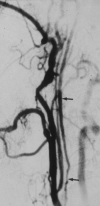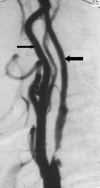Carotid Near-Occlusion: A Comprehensive Review, Part 1--Definition, Terminology, and Diagnosis
- PMID: 26316571
- PMCID: PMC7960223
- DOI: 10.3174/ajnr.A4432
Carotid Near-Occlusion: A Comprehensive Review, Part 1--Definition, Terminology, and Diagnosis
Abstract
Carotid near-occlusion is distal ICA luminal collapse beyond a tight stenosis, where the distal lumen should not be used for calculating percentage stenosis. Near-occlusion with full ICA collapse is well-known, with a threadlike lumen. However, near-occlusion without collapse is often subtle and can be overlooked as a usual severe stenosis. More than 10 different terms have been used to describe near-occlusion, sometimes causing confusion. This systematic review presents what is known about carotid near-occlusion. In this first part, the foci are definition, terminology, and diagnosis.
© 2016 by American Journal of Neuroradiology.
Figures







Similar articles
-
Carotid Near-Occlusion: A Comprehensive Review, Part 2--Prognosis and Treatment, Pathophysiology, Confusions, and Areas for Improvement.AJNR Am J Neuroradiol. 2016 Feb;37(2):200-4. doi: 10.3174/ajnr.A4429. Epub 2015 Sep 3. AJNR Am J Neuroradiol. 2016. PMID: 26338908 Free PMC article.
-
Duplex ultrasound for diagnosing symptomatic carotid stenosis in the extracranial segments.Cochrane Database Syst Rev. 2022 Jul 11;7(7):CD013172. doi: 10.1002/14651858.CD013172.pub2. Cochrane Database Syst Rev. 2022. PMID: 35815652 Free PMC article.
-
Accurate, practical and cost-effective assessment of carotid stenosis in the UK.Health Technol Assess. 2006 Aug;10(30):iii-iv, ix-x, 1-182. doi: 10.3310/hta10300. Health Technol Assess. 2006. PMID: 16904049
-
A rapid and systematic review of the clinical effectiveness and cost-effectiveness of paclitaxel, docetaxel, gemcitabine and vinorelbine in non-small-cell lung cancer.Health Technol Assess. 2001;5(32):1-195. doi: 10.3310/hta5320. Health Technol Assess. 2001. PMID: 12065068
-
Assessing the comparative effects of interventions in COPD: a tutorial on network meta-analysis for clinicians.Respir Res. 2024 Dec 21;25(1):438. doi: 10.1186/s12931-024-03056-x. Respir Res. 2024. PMID: 39709425 Free PMC article. Review.
Cited by
-
Carotid near-occlusion frequently has high peak systolic velocity on Doppler ultrasound.Neuroradiology. 2018 Jan;60(1):17-25. doi: 10.1007/s00234-017-1938-4. Epub 2017 Nov 25. Neuroradiology. 2018. PMID: 29177789
-
Endovascular Treatment for Near Occlusion of the Internal Carotid Artery : 30-Day Outcome and Long-Term Follow-Up.Clin Neuroradiol. 2018 Jun;28(2):245-252. doi: 10.1007/s00062-016-0546-8. Epub 2016 Oct 25. Clin Neuroradiol. 2018. PMID: 27783127
-
A Novel Window Into Human Vascular Remodeling and Diagnosing Carotid Flow Impairment: The Petro-Occipital Venous Plexus.J Am Heart Assoc. 2023 Oct 17;12(20):e031832. doi: 10.1161/JAHA.123.031832. Epub 2023 Oct 13. J Am Heart Assoc. 2023. PMID: 37830353 Free PMC article.
-
Relevance of Distal Arterial Collapse in Stenting of Atherosclerotic Near-Occlusion of the Carotid Artery.AJNR Am J Neuroradiol. 2020 Jun;41(6):1054-1060. doi: 10.3174/ajnr.A6570. Epub 2020 Jun 4. AJNR Am J Neuroradiol. 2020. PMID: 32499248 Free PMC article.
-
Carotid endarterectomy in patients with recurrent symptoms associated with an ipsilateral carotid artery near occlusion with full collapse.J Neurol. 2018 Aug;265(8):1900-1905. doi: 10.1007/s00415-018-8939-z. Epub 2018 Jun 18. J Neurol. 2018. PMID: 29916130 Free PMC article.
References
Publication types
MeSH terms
LinkOut - more resources
Full Text Sources
Miscellaneous
